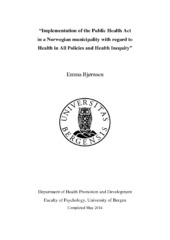"Implementation of the Public Health Act in a Norwegian municipality with regard to Health in all Policies and Health Inequity"
Master thesis
Permanent lenke
https://hdl.handle.net/1956/8217Utgivelsesdato
2014-05-20Metadata
Vis full innførselSamlinger
Sammendrag
Background In Norway, as in the rest of Europe, people live on average longer and healthier lives than previous generations but are faced with increasing health inequities revealing socio-ecological factors as the main reason. There still remains a gap in the knowledge of how to tackle social inequity in health (SIH). The Public Health Act, adopted in 2012 imposes Norwegian government to implement health in all policies (HiAP) and reduce SIH. The act is important for implementing health promotion in a long term perspective as a cross-sectoral assignment. Responding to the knowledge gap the research project SODEMIFA" was established in 2013. This study seeks to contribute to the project by providing knowledge to a broader understanding about how HiAP and SIH are addressed at municipal level. Objectives The main objective of this study is to investigate how a municipality implements the principle of HiAP and how SIH is handled in a structure of multilevel governance. How do different types of policies work together to reduce the health gap? What measures are taken? Is there any collaboration between and within sectors? These objectives will be examined by pursuing these research questions; 1) What kind of policies are in place at the municipal level concerning health promotion and social inequities? 2) How are social determinants of health (SDH) a subject to governance at the municipal level? 3) What interventions are made to reduce inequities in health? 4) Is there any collaboration in development of policies and actions between sectors? Theoretical framework The social determinants of the health model of Dahlgren and Whitehead provides the theoretical framework for this study. Methods The research questions were answered within the frames of a case study design, combining document content analyse and qualitative face to face interviews. Documents were municipal policy documents, while the interview respondents were the Mayor, the Councillor, the public health coordinator and heads of all sectors. Results and discussion The HiAP principle is anchored in the planning system and health promotion has a comprehensive and holistic cross-sectoral approach in the municipality. Structural, long-term programs, understood as health promotion policies aiming at combating SIH, are implemented in ordinary services instead of short-term projects led by contemporary employees from outside services. Both universal measures aimed at the whole population and measures targeting disadvantaged groups seem to be the chosen strategic policy. To facilitate for physical activity for all is a cross-sectoral mission. The child and adolescent sector where everyone can be reached in an early stage in life, is regarded as the most important sector, not the health sector. There seems to be a high level of collaboration between and within sectors. Health promotion was a prioritised concern in the municipality prior to the Public Health Act, but the act has made their effort stronger. Supportive leadership and long-term work with support from national networks and the county partnership seem to be important. The public health coordinator is perceived to play an important role. The position is located in staff close to the top-level, but a clear mandate and job description seems to be missing. There also seems to be a lack of a leader-group at top level. Conclusions The municipal policy
Utgiver
The University of BergenOpphavsrett
Copyright the author. All rights reservedBeslektede innførsler
Viser innførsler beslektet ved tittel, forfatter og emneord.
-
Attributes and consequences of health information systems data for antenatal care : Health status, health system performance and policy
Venkateswaran, Mahima (Doctoral thesis, 2019-11-05)Background: A routine health information system (RHIS) serves as an important source of data for monitoring health of clients and health system performance. All countries use RHIS data for some form of priority setting; ... -
A Critical Perspective on Mental Health News in Six European Countries: How Are “Mental Health/Illness” and “Mental Health Literacy” Rhetorically Constructed?
Van Beveren, Laura; Rutten, Kris; Hensing, Gunnel; Spyridoula, Ntani; Schønning, Viktor; Axelsson, Malin; Bockting, Claudi; Buysse, Ann; de Neve, Ine; Desmet, Mattias; Dewaele, Alexis; Giovazolias, Theodoros; Hannon, Dewi; Kafetsios, Konstantinos; Meganck, Reitske; Øverland, Simon Nygaard; Triliva, Sofia; Vandamme, Joke (Journal article; Peer reviewed, 2020)In this study, we aim to contribute to the field of critical health communication research by examining how notions of mental health and illness are discursively constructed in newspapers and magazines in six European ... -
Health managers’ views on the status of national and decentralized health systems for child and adolescent mental health in Uganda: a qualitative study
Akol, Angela; Engebretsen, Ingunn Marie S.; Skylstad, Vilde; Nalugya, Joyce; Ndeezi, Grace; Tumwine, James K. (Peer reviewed; Journal article, 2015-12-08)Background: Robust health systems are required for the promotion of child and adolescent mental health (CAMH). In low and middle income countries such as Uganda neuropsychiatric illness in childhood and adolescence represent ...
